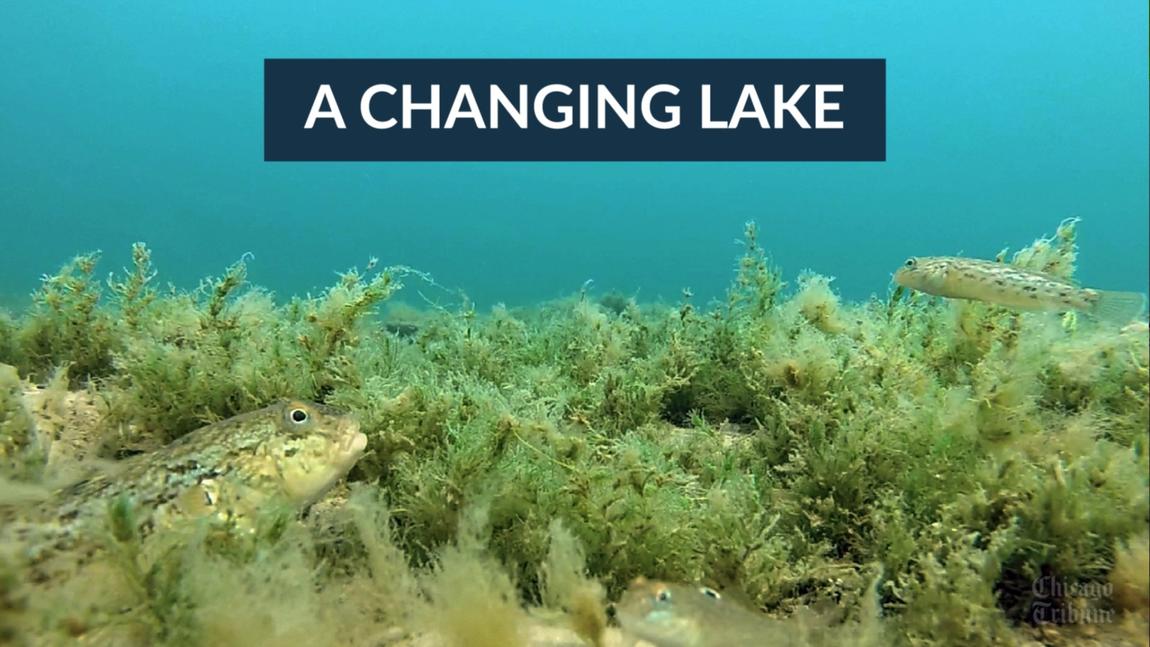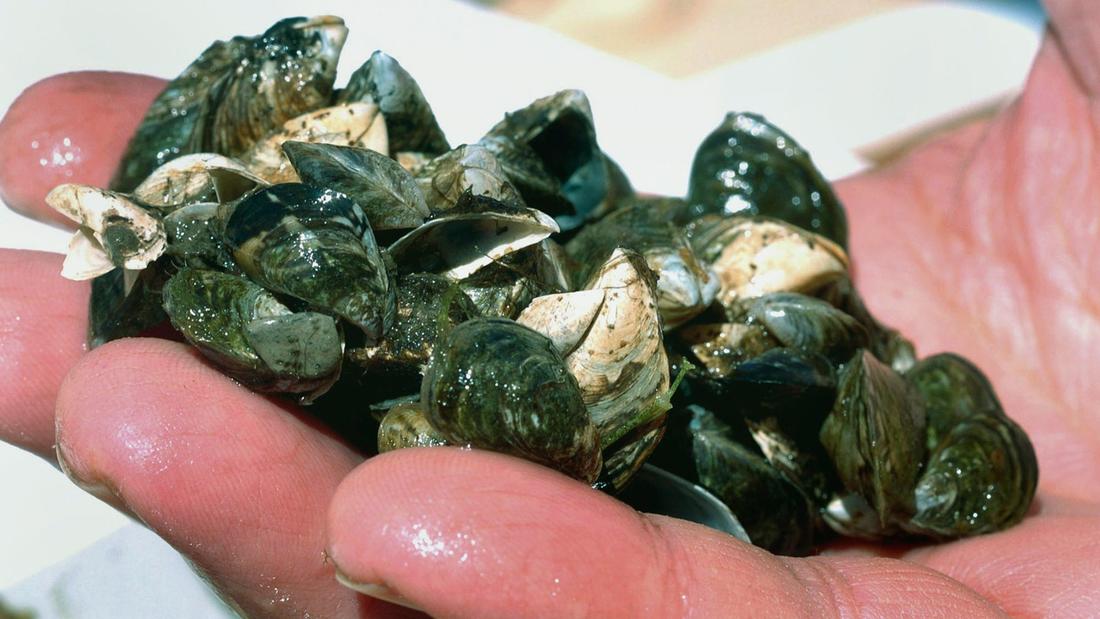Chicago Tribune
Lake Michigan has become dramatically clearer in last 20 years — but at a steep cost
 Over the past 20 years, Lake Michigan has undergone a dramatic transformation. Here’s a look at how invasive mussels have changed the lake’s landscape. (Jemal R. Brinson / Chicago Tribune)
Over the past 20 years, Lake Michigan has undergone a dramatic transformation. Here’s a look at how invasive mussels have changed the lake’s landscape. (Jemal R. Brinson / Chicago Tribune)
Tony Briscoe Chicago Tribune January 26, 2018
Decades ago, Lake Michigan teemed with nutrients and green algae, casting a brownish-green hue that resembled the mouth of an inland river rather than a vast, open-water lake.
Back then, the lake’s swampy complexion was less than inviting to swimmers and kayakers, but it supported a robust fishing industry as several commercial companies trawled for perch, and sport fishermen cast their lines for trout. But in the past 20 years, Lake Michigan has undergone a dramatic transformation.
In analyzing satellite images between 1998 and 2012, researchers at the Michigan Tech Research Institute were surprised to find that lakes Michigan and Huron are now clearer than Lake Superior. In a study published late last year, the researchers say limiting the amount of agricultural and sewage runoff in the lake has had an immense impact. However, the emergence of invasive mussels, which number in the trillions and have the ability to filter the entire volume of Lake Michigan in four to six days, has had an even greater effect.
“When you look at the scientific terms, we are approaching some oceanic values,” said Michael Sayers, a research engineer at Michigan Tech and co-author of the study. “We have some ways to go, but we are getting a lot closer to Lake Tahoe. A lot of times, you’ll hear from people that the water is so blue it compares to something in tropical areas.”
While appealing, the clarity comes at a significant cost to wildlife. In filtering the lake, the mussels have decimated the phytoplankton, a single-celled, green algae that serves as the base of the food chain. For much of the past decade, prey fish, like alewives, have remained at historic lows, prompting state managers to scale back the annual stocks of prized predators, such as king salmon.
The startling evolution has called into question the future of Great Lakes marine life and the region’s $7 billion fishing industry.
“Clearer is not necessarily better,” said Robert Shuchman, co-director of the Michigan Tech Research Institute. “Clearer water means less phytoplankton in the water column, and they’re the basic building block in the food web. The idea is, the little fish eat algae, and the bigger fish eat the little fish.
“There are some folks out there now that think Lake Michigan and Huron could become ecological deserts from a fishing standpoint. The food web could totally collapse because you don’t have the various organisms you need to sustain it.”
For ages, the phytoplankton fed the zooplankton, which were eaten by small, foraging fish. As the fast-filtering mussels reduce the plankton populations, there isn’t enough food to support the diet of many foraging fish. In addition, there’s not enough plankton or nutrients clouding the water to hide these small prey fish from predator fish.
“It’s a game of hide-and-seek in a brightly lit environment,” said Henry Vanderploeg, a research ecologist for the National Oceanic and Atmospheric Administration.
A different approach to fishing
After years of working aboard a relative’s charter boat, Rick Bentley was leaving the fishing industry in the early ’90s to pursue a career in finance when the mussels began arriving.
“A lot of people were sounding massive alarms about how the mussels could change everything,” recalled Bentley, 46.
Their fears turned out to be prophetic. As the water cleared up, the fish cleared out. Since the introduction of the mussels, there’s been a sharp decline in nearly all fish species in Lake Michigan, including king salmon, scientists say.
 In this May 3, 2007 photo, Inland Seas Education Association instructor Conrad Heins holds a cluster of zebra mussels that were taken from Lake Michigan off Suttons Bay, Mich. (John L. Russell / AP)
In this May 3, 2007 photo, Inland Seas Education Association instructor Conrad Heins holds a cluster of zebra mussels that were taken from Lake Michigan off Suttons Bay, Mich. (John L. Russell / AP)
At the height of king salmon fishing in the mid- to late-80s, around 10 million pounds of the fish were harvested from the lake each year, according to research by the U.S. Fish and Wildlife Service and agencies from four states. In recent years, fishermen are managing to nab only about 3 million pounds.
Despite the drop, Bentley, who had fond memories of fishing’s heyday, returned to the lake in 2007 with his own charter company, Windy City Salmon. The passion from his fishing days brought him back, but to survive, Bentley said, fishermen have to alter their age-old techniques.
“As a captain, fisherman and a businessman who wants to put out a good product, I know the lake is adapting, and we need to adapt with it,” Bentley said. “When I came back 10 years ago, many of the captains I knew were winding down their careers, ready to hang it up. Some adapted. Some of them stayed in their old ways, and their catches tended to suffer.”
King salmon are low-light-feeding fish, so with sunlight reaching into lower depths, it’s become increasingly difficult to catch them during midday hours, Bentley said. He’s found fishing at dawn and sundown provides the best chance to catch salmon.
The clearer waters have made flashers and dodgers, devices that reflect light and attract fish, more effective tools, Bentley said. Still, remaining undetected is a challenge.
“Generally, fish are more likely to keep their distance because they can see the boat and gear now,” he said.
A history of change
Over the years, the Great Lakes have endured numerous encounters with invasive species. The mussels may be the worst Lake Michigan has seen since the sea lamprey, an eel-like parasitic fish that slithered into the Upper Great Lakes in the 1940s through the Erie and Welland canals, according to David “Bo” Bunnell, a research fishery biologist at the U.S. Geological Survey’s Great Lakes Science Center. Sea lampreys latched onto large fish and drained their blood, leading to a collapse in populations of native predators like lake trout.
“They pretty much devastated native lake trout, lake whitefish and other native species that were already suffering from overfishing,” Bunnell said. “That was the one-two death punch.”
Without predators, the population of alewives, another nonnative species that came through the canals around the same time, went unchecked. Though they were abundant, the saltwater fish, already weakened from living in freshwater, befouled local beaches in spring die-offs after being exposed to higher temperature fluctuations when they came close to shore to spawn.
In the 1960s, coastal managers introduced two species of Pacific salmon to contain the alewives and boost fishing: coho and king. The king salmon brought the alewives under control and quickly became a favorite of sport fishermen.
“They get the biggest, they’re a very strong fish and they offer a helluva fight. They’re a 20-pound class fish, so they take 8 or 9 yards off the reel, and it might take 15 to 20 minutes to bring them in,” Bentley said.
The arrival of zebra and quagga mussels led to the collapse of alewives and king salmon in Lake Huron in the early 2000s. Scientists say the crash in alewives stemmed from less food availability and more predation by the king salmon, which was stocked bythe Michigan Department of Natural Resources and naturally reproducing. The king salmon diet is almost exclusively made up of alewives.
The Lake Huron king salmon, emaciated as their favorite prey became harder to find, migrated to Lake Michigan in search of alewives.
Nearly two decades later, the same progression is underway in Lake Michigan.
“There’s an old Chinese saying, ‘When there is crystal-clear water, there is no fish,’ ” said Yu-Chun Kao, a postdoctoral scientist at Michigan State University.
For a doctoral dissertation at the University of Michigan, Kao examined Lake Huron’s king salmon collapse, concluding the fishery that once existed likely won’t ever return to its glory days because of the alewife shortage.
Last year, Kao ran hundreds of computer simulations to consider changes in mussels, nutrients and fish stocking in Lake Michigan. His study suggested Lake Michigan might be better suited for lake trout and steelhead, given the two species of trout can switch from eating alewives to bottom-dwelling round goby, an invasive prey fish that eats cladophora and tiny quagga mussels.
The king salmon, he found, is the most susceptible to changes driven by the mussels, meaning its numbers will likely continue to decline as the mussels continue to spread. But there’s still a chance Lake Michigan could support a substantial salmon population if stocking is reduced to alleviate pressure on the struggling alewife population.
Lake Superior may have relinquished its title of clearest of the Great Lakes, but it also doesn’t have the same vulnerabilities to some invasive species as the other lakes. It has staved off the mussel migration because it’s colder and there’s less calcium in its water, a mineral the mussels need to make their shells.
Stocking the Great Lakes
Since 1984, the state of Illinois has raised fish to stock Lake Michigan at Jake Wolf Memorial Hatchery in Topeka, Ill., where the staff oversees eggs until they grow into fingerlings. Built atop a massive aquifer, the facility draws water into its network of concrete raceways and plastic-lined ponds, where it has up to 15 species of cold-, cool- and warm-water fish.
Each year, the hatchery staff, which works with state biologists, rears millions of fish in hopes of supporting a stable ecosystem and decent season for anglers. The upheaval in the food chain has made it all the more challenging.
 Rainbow trout in a “raceway” at the Jake Wolf Memorial Fish Hatchery located in Topeka, Ill. on July 18, 2017. (Jose M. Osorio / Chicago Tribune)
Rainbow trout in a “raceway” at the Jake Wolf Memorial Fish Hatchery located in Topeka, Ill. on July 18, 2017. (Jose M. Osorio / Chicago Tribune)
“It’s a daunting task,” hatchery manager Steve Krueger said. “Without stocking, I think the fishery in Lake Michigan would continue to falter.”
Stocking has also become more calculated in recent years — for Illinois and the three other states, Wisconsin, Indiana and Michigan, that border the lake.
In 2006, all of the alewives in Lake Michigan weighed nearly 10,000 metric tons, roughly the weight of the Eiffel Tower, according to U.S. Geological Survey estimates. By 2016, the entire prey fish population in Lake Michigan, including alewives and a half-dozen other species, weighed about 11,000 metric tons.
In response to the lack of alewives, fishery managers around Lake Michigan have called for reducing the number of king salmon at least twice in the past decade. In 2013, they slashed the number by 50 percent, releasing 1.8 million into the lake, down from 3.3 million the previous year. Last year, managers proposed making even deeper cuts, stocking only 690,000 king salmon, a 62 percent reduction from 2016.
 People walk along the Lakefront Trail near North Avenue Beach in Chicago on Saturday, July 29, 2017. (Alexandra Wimley/Chicago Tribune) (Alexandra Wimley / Chicago Tribune)
People walk along the Lakefront Trail near North Avenue Beach in Chicago on Saturday, July 29, 2017. (Alexandra Wimley/Chicago Tribune) (Alexandra Wimley / Chicago Tribune)
New threats loom
In addition to filtering the water, mussels have also altered the landscape of the lake bed.
The voracious eaters are polluting the lake bottom with feces. As sunlight reaches greater depths, it converts nutrients from the mussels’ excrement into a nuisance algae known as cladophora.
During storms, wave action rips up the carpet-esque algae and washes it ashore, where it is known for its potent stench and propensity to kill birds.
The growth in cladophora raises alarms, because it could help establish Lake Michigan’s next potential invasive species: Asian carp. The species has invaded the Mississippi River system and has been reported just 9 miles from Lake Michigan.
Asian carp rely on plankton, which they may not find if it reaches the lake, but researchers say the fish also feed on cladophora. Researchers say there may no longer be enough food for the Asian carp in open waters, but there is likely enough floating algae and cladophora near shore to sustain them.
A sliver of hope
Scientists say the invasive mussels may have reached their limits. With less plankton, the concentration of mussels in Lake Michigan dropped 40 percent between 2010 and 2015, according to a yet-to-be published report by Buffalo State University’s Great Lakes Center. But the total weight of mussels in the lake has risen, suggesting the surviving mussels are growing larger, said Alexander Karatayev, the center’s director. It’s unclear what this might mean in the future.
“However, it is extremely important to keep monitoring the (quagga mussel) population to understand if this decline is a long-term trend and if the population eventually will stabilize or will fluctuate substantially,” Karatayev said.
For now, better fisheries management has helped Lake Michigan see a return of lake trout.
The sport has changed for fishermen like Bentley, but he said there’s always been something biting on the end of his line.
Last year was the best in several years, he said. Though king salmon catches remained low, many of the fish from yesteryear, like lake trout, seem to be returning.
“We’ve seen Lake Michigan go through a lot of changes, but it all seems to work out and it always ends up being OK,” Bentley said. “Last two years, I’ve been encouraged by the comeback. I don’t think we’ll ever see the heyday of king salmon, but I think they’ll always be available.”
RELATED
Study: Lakes Michigan, Huron top Superior in water clarity »
States to reduce stocking of salmon and trout in Lake Michigan »
Asian carp discovered close to Lake Michigan as Trump pushes budget cuts


 Getty Images
Getty Images Getty Images
Getty Images New report finds skyrocketing wealth growth among the already rich is coupled with stagnant wages and persistent poverty among the lowest economic rungs of society. (Maslowski Marcin / Shutterstock.com)
New report finds skyrocketing wealth growth among the already rich is coupled with stagnant wages and persistent poverty among the lowest economic rungs of society. (Maslowski Marcin / Shutterstock.com) 
 Robert S. Mueller III, the special counsel overseeing the Russia investigation. CreditDoug Mills/The New York Times
Robert S. Mueller III, the special counsel overseeing the Russia investigation. CreditDoug Mills/The New York Times Donald F. McGahn II, the White House counsel, believed that firing Mr. Mueller would have a catastrophic impact on the presidency and would raise more questions about whether the White House was trying to obstruct the Russia investigation. CreditTom Williams/CQ Roll Call, via Associated Press
Donald F. McGahn II, the White House counsel, believed that firing Mr. Mueller would have a catastrophic impact on the presidency and would raise more questions about whether the White House was trying to obstruct the Russia investigation. CreditTom Williams/CQ Roll Call, via Associated Press President Trump said that Mr. Mueller, who had been a member of his golf club in Sterling, Va., left it years ago after a disagreement about club fees. CreditAl Drago for The New York Times
President Trump said that Mr. Mueller, who had been a member of his golf club in Sterling, Va., left it years ago after a disagreement about club fees. CreditAl Drago for The New York Times